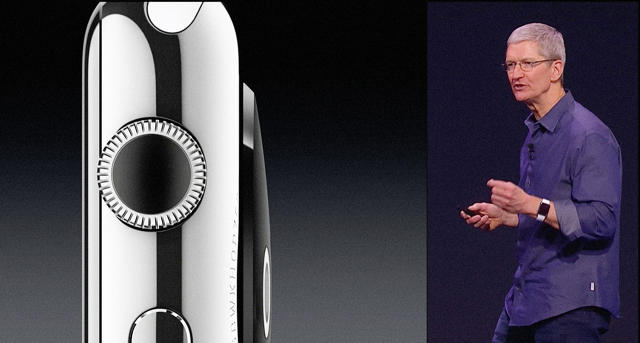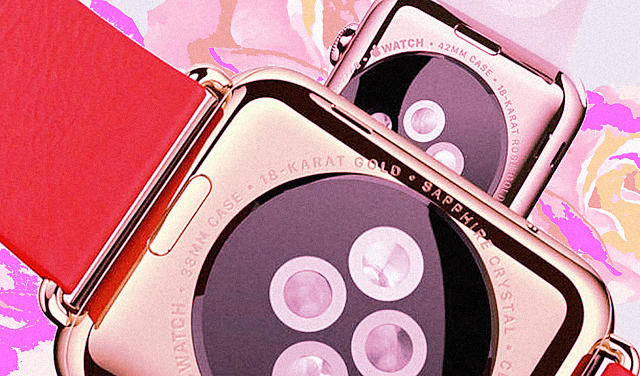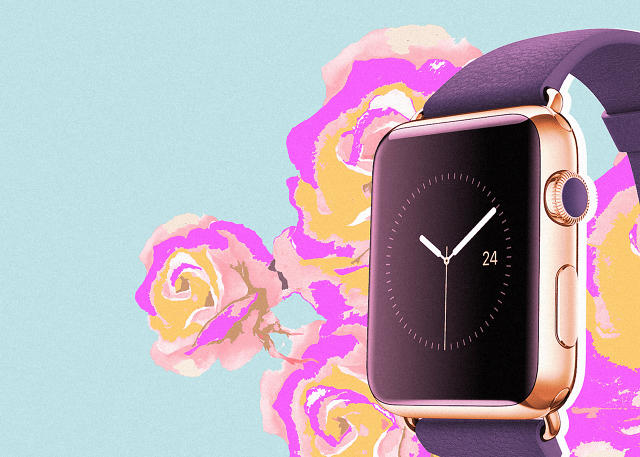When it comes to Apple, what’s a flop? I struck a nerve when I called the Apple Watch a flop. Quartz’s Dan Frommer, for example, isn’t having it: “It is silly to call it a massive success yet, but it is equally foolish to call it a flop. It is simply too early, and not enough is known.”
Look: whatever. Given enough sticktoitiveness, Apple’s going to sell anything it brings to market. It’s one of the largest companies in the world. It has a supply chain that spans the globe and the finest marketing machine in the business. But while it’s seemingly inevitable that the company will iterate and refine the Apple Watch into something better, this may be a case where Apple’s better still doesn’t change the marketplace. It’s possible Apple’s best smartwatch still hasn’t sold the public on smartwatches.

Even the worst-selling Apple product still pushes millions of units into the online and retail channel, but that doesn’t inherently mean that the Apple Watch will become a cultural phenomenon—and it forgets about the core economic principle of opportunity cost (namely, what could Apple have released if they dumped resources from the Apple Watch into a better product?). The iPhone sold 100 million units in three years. The iPad hit the same benchmark in two. The watch has another two Christmas retail seasons to reach that mark. Getting halfway would be more than respectable, but it wouldn’t equate to another Apple zeitgeist-defining moment.
So get hung up on the term “flop” if you want, but the only benchmark we have for success here is how Apple’s most recent products have performed, along with how Apple itself has talked about the watch. And Apple pulled out all the hyperbole.
“Apple needed to be more modest in how they set people’s expectations,” says Forrester principal analyst J. P. Gownder. “When Tim Cook pulled the whole, ‘Just one more thing,’ people were really expecting that. When you pull that stage trick out [saying] ‘this is the next big thing.'”
 Apple
Apple
When Tim Cook announced the Apple Watch, it wasn’t with the casual, hedged label of “an experiment,” as Jobs had revealed the Apple TV, which has taken 10 years to reach 25 million units sold. The Apple Watch had the aggressive marketing push only dedicated to its top products, along with very targeted promotion at Paris Fashion week and on the cover of Vogue China.
“We at Forrester never thought that the addressable market is going to be iPad- or iPhone-level,” Gownder says. “A lot of this is an expectations game. If you expect that everyone in America’s going to have an Apple Watch, that was a mistake from the beginning.”
Forrester estimated 10 million Apple Watches would sell in the first year—a stat somewhere between the existing worst estimates and the most generous ones. The bottom line is that no one knows what Apple’s internal sales targets were for the watch, and furthermore, the only way we’ll know how the Apple Watch is really selling is when Apple deigns to break out the numbers, as the company has with the iPhone and iPad (but—notably—failed to with the Apple TV until recently). And Apple won’t break out individual sales numbers until it has something to boast about.
“I think it’s quite interesting that they won’t release any sales information,” says Rachel Arthur, a senior analyst at the fashion trend forecasting firm WGSN. “Which is evidence in itself, I think, that it hasn’t done as well as they expected it to.”
An issue with my previous story was that the report from Slice Intelligence, the opt-in email monitoring service that noticed the 90% drop in recent Apple Watch purchase, didn’t count retail sales. Fair enough. Maybe the real sales had moved to Apple stores, where people could try on different watch models and bands.
If that’s the case, one could presume there’s evidence—albeit inferential—of Apple Watch’s healthy sales by assessing retail availability, or lack thereof. As of (July 19, 2015) morning, the $400 42mm black-on-black Apple Watch Sport base model was available at every last Apple retail store in America, according to Apple’s retail website. (That fashion-neutral model was one of the most popular in the beginning, according to Slice.) Every location in the United States had appointments open for an immediate morning fitting. (We started checking at 10 a.m. Eastern time, and there was an open 10:30 a.m. appointment available at almost every Apple Store; in a handful of stores across the country, we would have had to settle for an 11 a.m. appointment.) Every model we checked online, from aluminum Apple Sports to stainless steel Apple Watch models, was available for one-day shipping. Whatever retail or online demand there is for the Apple Watch, it is being easily met.
No one can say with certainty if the watch is a complete marketplace failure for the company, because it’s a new market, a new product, and not the only egg in their financial basket. But it’s clearly not a smash hit, either. As of today, the Apple Watch doesn’t appear to be the next iPhone- or iPad-class culture shifter for Apple.

Confused Utility
Let’s assume that Dawn Chmielewski from Re/Code’s reported best-case scenario of 21-million-unit sales by the end of the year is true, and the watch has garnered the support of early adopters. It’s hardly a sure sign of long-term success for the platform.
As Gartner Research VP Van Baker prognosticated before launch, “They should sell a few million of the Apple Watches pretty quickly. The question comes after the first two or three quarters once the Apple fans have bought. Will there be a market for the Apple Watch among the general consumer segment? That remains to be seen.” Today—right now—that still remains to be seen, and for the first time in recent history, Apple may actually be fighting an uphill battle when it enters second and third year mass-market adoption.
Gownder pragmatically points to a series of critical issues limiting the watch’s adoption by a wider market, from its lack of meaningful apps, to the very fact that the watch doesn’t offer any form of utility that’s vastly beyond what’s available with iPhone. Sure, your watch can unlock your hotel room door with the Starwood app, but your iPhone can handle the same task. “At that level of friction, the question is, are they fundamentally different?”
In fact, this problem of phone to watch differentiation is actually spilling into Apple’s confused TV advertisements. As Chris Welch describes the problem at The Verge, “…many people may see these and simply say, ‘Yeah, but my phone already does that.’ And they wouldn’t be wrong. Making a compelling case for why the Watch offers something different and something more is Apple’s main challenge. Selling people on a smartwatch—even the best one out today—in 30 seconds is extraordinarily difficult.”
No one asked if the iPhone had any fundamentally new utility when it launched (it was a better smartphone) or complained that it didn’t have apps (a term Apple hadn’t even invented yet), because it was such a manifestly obvious paradigm shift in user interface. (And it did have a killer app: Mobile Safari, the world’s first decent mobile web browsing experience.)

Questionable Fashion
And then there’s the fashion question: is the Apple Watch even something people want to wear now? Or in the future? Ignore the fashion question if you want, but remember: Apple didn’t.
“There are comparisons to the Casio calculator watch,” says Arthur, “and it’s not much further along from a design perspective.”
(Personally, I think the Apple Watch looks more like a Brando MP4-playing watch I bought in 2006, with a nicer band and bezel.)
“Speaking from a trend driven perspective, if this is something that’s successful for them, they would need to dig deeper and create a way for it to evolve itself,” says Jaime Barr a senior analyst of Footwear and Accessories at WGSN. “They make one iPad, or iPod in many colors, but that’s not a wearable tech. You get into wearable tech, and you’re crossing into accessories.”
Fashion accessories—like glasses, shoes, ties, and yes, watches—come in billions of options, reminds Barr. She believes the Apple Watch’s existing band and digital face customization doesn’t go far nearly enough for something you wear every day. People who wear watches wear multiple watches, of vastly different physical design, from sinuous Skagens to the hulking designs of Michael Kors. Basically, Apple would need to sell a whole lot of different Apple Watches for the product to ever graduate beyond geek gear.

When I bring up the counterpoint that iconic Raybans have gone in and out of style multiple times in my lifetime, but the business still stuck around, she points out that while this is entirely true, Rayban as a company survives by selling options other than its namesake frames—from aviators to thick-framed sportswear products—and that with its watch, Apple may need to do the same thing.
But what about the old Rolex argument? That one great accessory can last forever? “I don’t think, as it stands now from an aesthetic perspective, it would be able to stand some sort of seasonless wear,” Barr says with a polite dismissiveness.
Nobody outside Apple—including me, you, and any third party—knows exact Apple Watch sales numbers. (Apple declined to comment on Apple Watch sales for this piece.)
But in its current form—the one on sale right now—the Apple Watch is not a very useful product. It’s not a very fashionable product. And according to friendly anecdotes, early reviews, analysts I’ve spoken to, and what precious little information about sales we actually have, it’s not a product that most people actually yet want.
So you don’t like the term “flop”? That’s fine! I guess not everyone expects as much out of Apple as I do.
Sign up to learn more about Fast Company’s Innovation Festival in November
See Fast Company’s Mark Wilson and Noah Robischon discuss the Apple Watch on The 29th Floor: